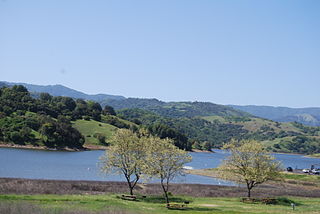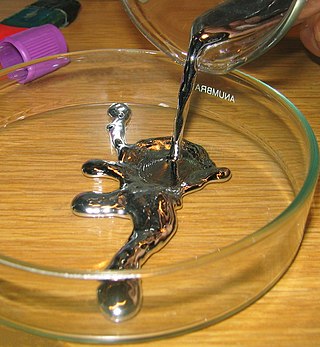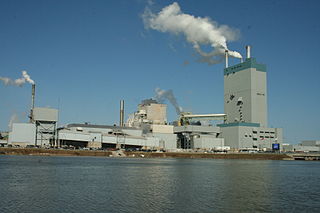Related Research Articles

Thiomersal (INN), or thimerosal, also sold under the name merthiolate is an organomercury compound. It is a well-established antiseptic and antifungal agent.

Neurotoxins are toxins that are destructive to nerve tissue. Neurotoxins are an extensive class of exogenous chemical neurological insults that can adversely affect function in both developing and mature nervous tissue. The term can also be used to classify endogenous compounds, which, when abnormally contacted, can prove neurologically toxic. Though neurotoxins are often neurologically destructive, their ability to specifically target neural components is important in the study of nervous systems. Common examples of neurotoxins include lead, ethanol, glutamate, nitric oxide, botulinum toxin, tetanus toxin, and tetrodotoxin. Some substances such as nitric oxide and glutamate are in fact essential for proper function of the body and only exert neurotoxic effects at excessive concentrations.

Mercury poisoning is a type of metal poisoning due to exposure to mercury. Symptoms depend upon the type, dose, method, and duration of exposure. They may include muscle weakness, poor coordination, numbness in the hands and feet, skin rashes, anxiety, memory problems, trouble speaking, trouble hearing, or trouble seeing. High-level exposure to methylmercury is known as Minamata disease. Methylmercury exposure in children may result in acrodynia in which the skin becomes pink and peels. Long-term complications may include kidney problems and decreased intelligence. The effects of long-term low-dose exposure to methylmercury are unclear.

Oily fish are fish species with oil (fats) in soft tissues and in the coelomic cavity around the gut. Their fillets may contain up to 30% oil, although this figure varies both within and between species. Examples of oily fish include small forage fish such as sardines, herring and anchovies, and other larger pelagic fish such as salmon, trout, tuna, swordfish and mackerel.

Fetal alcohol spectrum disorders (FASDs) are a group of conditions that can occur in a person who is exposed to alcohol as a result of their mother drinking during pregnancy. Symptoms can include an abnormal appearance, short height, low body weight, small head size, poor coordination, behavioral problems, learning difficulties, and problems with hearing and sight. Those affected are more likely to have trouble with school, the legal system, alcohol, other drugs, and other areas of high risk. The several forms of the condition are: fetal alcohol syndrome (FAS), partial fetal alcohol syndrome (pFAS), alcohol-related birth defects (ARBD), static encephalopathy, alcohol-related neurodevelopmental disorder (ARND) and neurobehavioral disorder associated with prenatal alcohol exposure (ND-PAE). As of 2016, the Swedish Agency for Health Technology Assessment and Assessment of Social Services accepted only FAS as a diagnosis, seeing the evidence as inconclusive with respect to other types.

Methylmercury (sometimes methyl mercury) is an organometallic cation with the formula [CH3Hg]+. It is the simplest organomercury compound. Methylmercury is extremely toxic, and its derivatives are the major source of organic mercury for humans. It is a bioaccumulative environmental toxicant with a 50-day half-life.

Biomagnification, also known as bioamplification or biological magnification, is the increase in concentration of a substance, e.g a pesticide, in the tissues of organisms at successively higher levels in a food chain. This increase can occur as a result of:
Ethylmercury (sometimes ethyl mercury) is a cation composed of an organic CH3CH2- species (an ethyl group) bound to a mercury(II) centre, making it a type of organometallic cation, and giving it a chemical formula C2H5Hg+. The main source of ethylmercury is thimerosal.
Environmental toxicants and fetal development is the impact of different toxic substances from the environment on the development of the fetus. This article deals with potential adverse effects of environmental toxicants on the prenatal development of both the embryo or fetus, as well as pregnancy complications. The human embryo or fetus is relatively susceptible to impact from adverse conditions within the mother's environment. Substandard fetal conditions often cause various degrees of developmental delays, both physical and mental, for the growing baby. Although some variables do occur as a result of genetic conditions pertaining to the father, a great many are directly brought about from environmental toxins that the mother is exposed to.
Prenatal development includes the development of the embryo and of the fetus during a viviparous animal's gestation. Prenatal development starts with fertilization, in the germinal stage of embryonic development, and continues in fetal development until birth.

Nutrition and pregnancy refers to the nutrient intake, and dietary planning that is undertaken before, during and after pregnancy. Nutrition of the fetus begins at conception. For this reason, the nutrition of the mother is important from before conception as well as throughout pregnancy and breastfeeding. An ever-increasing number of studies have shown that the nutrition of the mother will have an effect on the child, up to and including the risk for cancer, cardiovascular disease, hypertension and diabetes throughout life.

The Guadalupe River watershed consists of 170 square miles (400 km2) of land within northern California's Santa Clara County. The surface runoff from this area drains into the Guadalupe River, its tributary streams, reservoirs or other bodies of water which all eventually gets carried into the San Francisco Bay. Essentially, all the water from the creeks and rivers that make up the Guadalupe watershed, including water from storm drains, flows into the Guadalupe River, and then flows downstream into the San Francisco Bay at the Alviso Slough in Alviso. The Guadalupe watershed's main tributaries include Los Gatos Creek, Trout Creek, Hendrys Creek, Ross Creek, Pheasant Creek, Rincon Creek, Herbert Creek, and Golf Creek. Six major reservoirs exist in the watershed: Calero Reservoir on Arroyo Calero, Guadalupe Reservoir on Guadalupe Creek, Almaden Reservoir on Los Alamitos Creek, Vasona Reservoir, Lexington Reservoir, and Lake Elsman on Los Gatos Creek.
Environment and intelligence research investigates the impact of environment on intelligence. This is one of the most important factors in understanding human group differences in IQ test scores and other measures of cognitive ability. It is estimated that genes contribute about 20–40% of the variance in intelligence in childhood and about 80% in adulthood. Thus the environment and its interaction with genes account for a high proportion of the variation in intelligence seen in groups of young children, and for a small proportion of the variation observed in groups of mature adults. Historically, there has been great interest in the field of intelligence research to determine environmental influences on the development of cognitive functioning, in particular, fluid intelligence, as defined by its stabilization at 16 years of age. Despite the fact that intelligence stabilizes in early adulthood it is thought that genetic factors come to play more of a role in our intelligence during middle and old age and that the importance of the environment dissipates.

Mercury is a chemical element; it has symbol Hg and atomic number 80. It is also known as quicksilver and was formerly named hydrargyrum from the Greek words hydor (water) and argyros (silver). A heavy, silvery d-block element, mercury is the only metallic element that is known to be liquid at standard temperature and pressure; the only other element that is liquid under these conditions is the halogen bromine, though metals such as caesium, gallium, and rubidium melt just above room temperature.

The presence of mercury in fish is a health concern for people who eat them, especially for women who are or may become pregnant, nursing mothers, and young children. Fish and shellfish concentrate mercury in their bodies, often in the form of methylmercury, a highly toxic organomercury compound. This element is known to bioaccumulate in humans, so bioaccumulation in seafood carries over into human populations, where it can result in mercury poisoning. Mercury is dangerous to both natural ecosystems and humans because it is a metal known to be highly toxic, especially due to its neurotoxic ability to damage the central nervous system.

The hormonal theory of sexuality holds that, just as exposure to certain hormones plays a role in fetal sex differentiation, such exposure also influences the sexual orientation that emerges later in the individual. Prenatal hormones may be seen as the primary determinant of adult sexual orientation, or a co-factor with genes, biological factors and/or environmental and social conditions.

Mercury regulation in the United States limit the maximum concentrations of mercury (Hg) that is permitted in air, water, soil, food and drugs. The regulations are promulgated by agencies such as the Environmental Protection Agency (EPA) and Food and Drug Administration (FDA), as well as a variety of state and local authorities. EPA published the Mercury and Air Toxics Standards (MATS) regulation in 2012; the first federal standards requiring power plants to limit emissions of mercury and other toxic gases.

Mercury is a heavy metal that cycles through the atmosphere, water, and soil in various forms to different parts of the world. Due to this natural mercury cycle, irrespective of which part of the world releases mercury it could affect an entirely different part of the world making mercury pollution a global concern. Mercury pollution is now identified as a global problem and awareness has been raised on an international action plan to minimize anthropogenic mercury emissions and clean up mercury pollution. The 2002 Global Mercury Assessment concluded that "International actions to address the global mercury problem should not be delayed". Among many environments that are under the impact of mercury pollution, the ocean is one which cannot be neglected as it has the ability to act as a "storage closet" for mercury. According to a recent model study the total anthropogenic mercury released into the ocean is estimated to be around 80,000 to 45,000 metric tons and two-thirds of this amount is estimated to be found in waters shallower than 1000m level where much consumable fish live. Mercury can bioaccumulate in marine food chains in the form of highly toxic methylmercury which can cause health risks to human seafood consumers. According to statistics, about 66% of global fish consumption comes from the ocean. Therefore, it is important to monitor and regulate oceanic mercury levels to prevent more and more mercury from reaching the human population through seafood consumption.
Mercury contamination in California waterways poses a threat to both the environment and human health. This naturally occurring heavy metal may be released into the environment from natural geological sources, but most commonly occurs from anthropogenic mining operations. This metal poses a threat not only for its effects on organisms, but also for difficulty of removal from waterways and the trouble in efficiently detecting it. The roots of mercury poisoning in waterways began with the historic mining of gold within California's streambed and hillsides; since the California Gold Rush, mercury has been used for gold extraction for its ability as a catalyze with the precious metal. due to the process of extraction and washing, mercury used would either be burned away as a hazardous vapor, or washed away into waterflows, resulting in widespread contamination of river and lake sediments. mercury continues to be released today through anthropogenic sources, though state and federal agencies work to manage and ban these practices and to mitigate its effect on the environmental and on people. Many water bodies in the state of California bear fish consumption advisories due to mercury content.

Mercury contamination in Grassy Narrows was an uncontrolled discharge of between 9,000 kilograms (20,000 lb) and 11,000 kilograms (24,000 lb) of mercury from the Dryden Mill's chloralkali plant in Dryden into the headwaters of the Wabigoon River in the Kenora District of Northwestern Ontario from 1962 until 1970. It was described as "one of the worst cases of environmental poisoning in Canadian history." The contamination poisoned many people in the Grassy Narrows First Nation and Whitedog First Nation communities
References
- ↑ "Seychelles Child Development Study". University of Rochester . Retrieved 31 October 2013.
- 1 2 Myers, G. J.; Davidson, P. W.; Cox, C.; Shamlaye, C. F.; Choisy, O.; Cernichiari, E.; Choi, A.; Sloane-Reeves, J.; Axtell, C.; Gao, P.; Clarkson, T. W. (1997). "The seychelles child development study: Results and new directions through twenty-nine months". Water, Air, & Soil Pollution. 97 (1–2): 53–61. Bibcode:1997WASP...97...53M. doi:10.1007/BF02409644. S2CID 189833623.
- ↑ Myers, G. J.; Davidson, P. W.; Cox, C.; Shamlaye, C. F.; Palumbo, D.; Cernichiari, E.; Sloane-Reeves, J.; Wilding, G. E.; Kost, J.; Huang, L. S.; Clarkson, T. W. (2003). "Prenatal methylmercury exposure from ocean fish consumption in the Seychelles child development study". The Lancet. 361 (9370): 1686–1692. doi:10.1016/S0140-6736(03)13371-5. PMID 12767734. S2CID 20098326.
- ↑ Myers, G. J.; Davidson, P. W.; Shamlaye, C. F.; Axtell, C. D.; Cernichiari, E.; Choisy, O.; Choi, A.; Cox, C.; Clarkson, T. W. (1997). "Effects of prenatal methylmercury exposure from a high fish diet on developmental milestones in the Seychelles Child Development Study". Neurotoxicology. 18 (3): 819–829. PMID 9339828.
- ↑ Crump, K. S.; Van Landingham, C.; Shamlaye, C.; Cox, C.; Davidson, P. W.; Myers, G. J.; Clarkson, T. W. (2000). "Benchmark concentrations for methylmercury obtained from the Seychelles Child Development Study". Environmental Health Perspectives. 108 (3): 257–263. doi:10.1289/ehp.00108257. PMC 1637982 . PMID 10706533.
- ↑ Van Wijngaarden, E.; Thurston, S. W.; Myers, G. J.; Strain, J. J.; Weiss, B.; Zarcone, T.; Watson, G. E.; Zareba, G.; McSorley, E. M.; Mulhern, M. S.; Yeates, A. J.; Henderson, J.; Gedeon, J.; Shamlaye, C. F.; Davidson, P. W. (2013). "Prenatal methyl mercury exposure in relation to neurodevelopment and behavior at 19 years of age in the Seychelles Child Development Study". Neurotoxicology and Teratology. 39: 19–25. doi:10.1016/j.ntt.2013.06.003. PMC 3795956 . PMID 23770126.
- ↑ Davidson, P. W.; Leste, A.; Benstrong, E.; Burns, C. M.; Valentin, J.; Sloane-Reeves, J.; Huang, L. S.; Miller, W. A.; Gunzler, D.; Van Wijngaarden, E.; Watson, G. E.; Zareba, G.; Shamlaye, C. F.; Myers, G. J. (2010). "Fish consumption, mercury exposure, and their associations with scholastic achievement in the Seychelles Child Development Study☆". NeuroToxicology. 31 (5): 439–447. doi:10.1016/j.neuro.2010.05.010. PMC 2934742 . PMID 20576509.
- ↑ Van Wijngaarden, E.; Davidson, P. W.; Smith, T. H.; Evans, K.; Yost, K.; Love, T.; Thurston, S. W.; Watson, G. E.; Zareba, G.; Burns, C. M.; Shamlaye, C. F.; Myers, G. J. (2013). "Autism Spectrum Disorder Phenotypes and Prenatal Exposure to Methylmercury". Epidemiology. 24 (5): 651–659. doi:10.1097/EDE.0b013e31829d2651. PMC 3732522 . PMID 23873071.
- ↑ Willingham, Emily (24 July 2013). "Mercury and autism not linked, again". Forbes.com . Retrieved 31 October 2013.
- ↑ "Seychelles". University of Ulster. Retrieved 2 November 2013.